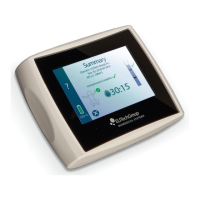93
APPENDIX D
Procedure for High Skin Resistance
Almost all of the electrical resistance in an iontophoretic circuit is provided by the two skin areas
involved, and is due to the relatively dry dead cell layer of the epidermis, which varies in thickness
according to location and also between individuals. When iontophoresis begins, the resistance is
high, but rapidly reduces as the ducts begin to carry salt-containing sweat to the skin surface. In
the majority of cases, the standard pre-cleaning procedure will suffice:
• Rub skin briskly with isopropyl alcohol and water to remove excess skin oils.
• Wash skin vigorously with deionized water to remove as much dead cell material as
possible.
• Finally, wet the site under the planned iontophoresis location with deionized water just
before applying Pilogel to lower resistance to satisfactory levels.

